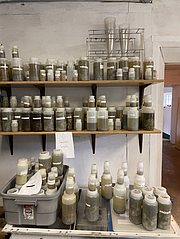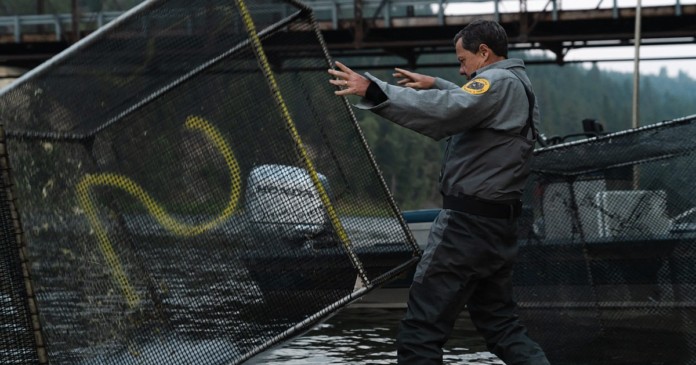On an overcast day in mid-June last year, Jim Dunnigan, dam mitigation coordinator for Montana Fish, Wildlife and Parks, stood on a concrete embankment overlooking the Kootenai River near Libby.
The high, gray wall of Libby Dam loomed to his left and a steep slope of boulders descended to the water in front of him. A colleague crouched by the river and returned with a dripping fistful of gray-brown slime, dropping it with an audible plop on a nearby bench. The two men teased apart the gooey mass, revealing rough, fibrous strands like wet cotton.
For the past 20 years, Dunnigan has watched as thick mats of Didymosphenia geminata — also known as didymo or “rock snot” — have blanketed the riverbed below Libby Dam, wondering what it might be doing to the aquatic ecosystem. The mats exist year-round below the dam, but growth peaks between February and May.
Didymo is a benthic diatom, a type of microscopic algae that clings to river rocks. Sediment cores and fossil records show that didymo has existed in the northern hemisphere for hundreds of years to millennia. But in recent decades, didymo has begun to “bloom” in rivers around the world, coating river bottoms with what looks like shaggy brown carpet. The phenomenon baffles scientists because didymo doesn’t act like normal algae.
Algal blooms typically occur when there is a high amount of nutrients in the water from sources such as sewage effluent or agricultural runoff. Didymo, on the other hand, tends to produce a thick mat when nutrients, specifically phosphorus, are low. Scientists are still looking for a clear answer to what triggers the blooms, which are occurring more often and in more places. A growing body of research links them to climate change.
But while the cause of the blooms remains elusive, Dunnigan’s new research has identified one of the blooms’ effects. The study found that nutrient availability and winter didymo blooms are the top variables tied to stunted rainbow trout growth. Trout size impacts FWP’s constituents, namely anglers, but Dunnigan says the larger issue is Libby Dam, which is creating a nutrient imbalance that impairs the aquatic food web. To fix the problem, Dunnigan recently proposed a curious solution: adding fertilizer to the river.
Libby Dam blocks 80-93% of upstream phosphorus from entering the Kootenai River. Phosphorus is an essential building block for algae, which provides food for macroinvertebrates and fish. By holding back phosphorus, the dam also creates ideal conditions for didymo blooms. Dunnigan’s theory is that the blooms drive away larger bugs that fish like to eat, which in turn limits fish growth. By installing a fertilizer drip below the dam, Dunnigan hopes he can reduce didymo blooms and restore a healthier food chain, from algae to insects to fish.
Adding nutrients to support fish in the Kootenai River basin is a strategy that has been tried before. Two other government and tribal programs currently add commercial-grade fertilizer to the watershed: one 50 miles downstream just over the Idaho-Montana border and the other in Canada’s Kootenay Lake. These nutrient addition programs were created, in large part, to replace nutrients trapped by Libby Dam and to restore fish health.
Dunnigan’s proposal is to add fertilizer at the Libby Dam outflow for five years, assess the results, and then decide whether to continue. If approved, the program would be the first of its kind in Montana and the only nutrient addition program in the Kootenai drainage in response to the impact of rock snot.
At first glance, adding nutrients to waterways goes against what many scientists have been taught. Travis Schmidt, a research ecologist for the U.S. Geological Survey’s Wyoming-Montana Water Science Center, says using nutrients as a restoration tool can feel wrong when so much of the world is focused on keeping nutrients out of rivers to discourage harmful algal blooms, which can suck oxygen from aquatic ecosystems and degrade water quality.
“Adding nutrients to a system is, to most stream ecologists and biologists, going to elicit a negative reaction,” Schmidt said. But, he adds, the Kootenai River’s low-phosphorus environment is unusual and may require a different type of management to mitigate the dam’s effects, including didymo blooms.
“In the absence of [adding nutrients], I don’t know how you solve the problem,” Schmidt said.
Back at his office, Dunnigan scrolled through spreadsheets of data on his computer.
On his door hangs a carved wooden sign that reads “Gone Fishing.” A sticker fixed to the door frame advises, “Use Biology to Manage Fish and Wildlife.” A row of well-worn textbooks with titles like “Biostatistical Analysis” and “Age and Growth of Fish” stocks a bookshelf behind his desk.
“I got into science because I was interested in figuring out how nature worked,” Dunnigan said.
Dunnigan has worked for Montana Fish, Wildlife and Parks for just over 20 years and is now one of the most senior biologists on staff. And he recognizes that FWP has limited power when it comes to decisions that affect the river.
“We’re a small cog in the wheel of that process,” he said, explaining that the Army Corps of Engineers operates the dam and the Bonneville Power Administration sells the electricity it generates. FWP is charged with fulfilling a specific state mandate: to conserve and provide opportunities for Montanans to enjoy fish and wildlife resources.
“It’s because of that [mandate] — to provide opportunity and improve opportunity for angling — that we’re concerned about didymo,” Dunnigan said. “Because we think it’s having an impact on the trout.”
Dunnigan says that the low phosphorus levels below the dam are only part of the reason didymo blooms are happening. Nitrogen levels are also unnaturally high due to Canadian mining activity upstream, which creates a nutrient imbalance.
“Because Libby Dam is trapping the phosphorus, and the nitrogen is artificially high, we are way out of whack,” Dunnigan said. Phosphorus attaches to sediment particles and settles out in the slow flow behind the dam, while nitrogen is more soluble and can pass through more easily.
This low-phosphorus, high-nitrogen environment, coupled with the low, stable flows created by the dam, seems to fuel didymo mat production — especially during the winter months when phosphorus, Dunnigan suspects, is particularly low due to lack of runoff.
Prior studies on the Kootenai River and on South Dakota’s Rapid Creek have shown that adding small amounts of phosphorus can significantly reduce didymo mats. Dunnigan’s hypothesis is that by adding phosphorus in the form of fertilizer, FWP can achieve the dual goal of eliminating didymo blooms and increasing the algae that support caddisflies, stoneflies and mayflies.
“[Didymo] shifts it more toward midges and black flies, very small critters that are not really all that desirable in terms of trout food,” Dunnigan said. “So that’s really the mechanism that we hope to move.”
If Dunnigan’s proposal is approved as presented, FWP would add a continuous stream of liquid ammonium polyphosphate fertilizer into the Kootenai River from January to September, beginning as early as Jan. 1, 2024. Dunnigan’s proposal estimates that the average annual fertilizer cost would be a little over $60,000.
The fertilizer would be added via a pipe attached to the middle of the David Thompson Bridge, just downstream of Libby Dam. The pipe would connect to a pumphouse on the riverbank.
As a pilot study, the project would offer a chance to see if Dunnigan’s theory is right.
“That’s the fun part,” Dunnigan said. “We developed a hypothesis [of] how the system is working, and now we designed an experiment to go out and test it.”
If the project is implemented, fisheries staff will monitor water quality and any changes in algal growth or invertebrate populations. Dunnigan and his team will electrofish every September below the dam — weighing, measuring, and adding a serial number, or “pit tag,” to each fish they capture — to see if individual fish are getting bigger. Dunnigan says rainbow trout growth will be the best metric to quantify whether the effort is working.
“We are informed, we care, and we’re trying to make things better — not just for the resource, but for the people that use it and enjoy it,” Dunnigan said.
Four miles downriver from the proposed project site is Dave Blackburn’s Kootenai Angler, one of the longest-running fly-fishing outfitters on the Montana stretch of the river.
Blackburn, who opened the business in 1985, still remembers how big the trout were when he first arrived from Wyoming in 1981.
“The Kootenai was like, holy mackerel — nobody’s fishing it. This was like a virgin river with big fish,” Blackburn said. “And so I figured it would be a good place to do what I wanted to do. It was a very healthy system.”
Blackburn says he first noticed didymo mats in the river around 2000, and he estimates that the fishery below Libby Dam is far less healthy than it was before didymo appeared. In addition to seeing fewer fish in the upper river, he said, dealing with the mats has been a nuisance.
“You could nymph the river before the didymo became a problem and never have to clean your hook. But now, if you hit bottom, you have to check your flies,” Blackburn said. He’s also had to field questions from clients who mistake dried chunks of didymo for toilet paper.
As a guide, Blackburn has had to come to terms with the new landscape.
“Didymo is just something we learned to live with,” Blackburn said. “As long as we have a low-nutrient, low-water, high-sunlight thing, I think it’s always going to be around.”
Asked about Dunnigan’s plan to add nutrients below the dam, Blackburn said he wishes it had started five to 10 years ago. If the project is approved, he said, he’s not concerned about negative impacts.
“The didymo is doing way more damage,” he said. “It’s pretty much limited us in how many trips we [can] do in the upper river.”
While much about didymo remains a mystery, new research links didymo blooms to warming temperatures and suggests that rock snot isn’t going away on its own.
A study published in 2020 points to receding glaciers as a possible explanation for the appearance of didymo blooms in mountain rivers and streams.
“The story of why didymo is blooming was sort of this evolving character,” said Dr. Janice Brahney, associate professor of watershed sciences at Utah State University and lead author of the study. “But there wasn’t a mechanism that linked the observations to the process. What we were able to show is that it’s a change in the timing.”
In a warming climate, Brahney explained, snow is melting earlier in the year and glaciers are receding, which changes river dynamics. Normally, snowmelt keeps water temperatures cool, brings in nutrients like phosphorus, and adds turbidity that shades the river bottom. Once spring snowmelt subsides, glacial runoff provides a buffer that helps maintain those conditions through the summer months.
But as glaciers disappear, so does the buffer, leading to a warmer, low-nutrient river exposed to more light, which favors didymo blooms.
Didymo, like all algae, generates energy through photosynthesis. When didymo has access to more nutrients, it can use that energy to divide itself and create new cells, says Lindsay Capito, Brahney’s former student and a co-author of the study. But without enough nutrients, didymo can’t divide. Instead, when exposed to high light, didymo generates excess photosynthetic energy that it must put somewhere, leading to the growth of longer and longer mucusy stalks. That process, called photosynthetic overflow, is what scientists think creates didymo’s thick, streambed-covering mats.
By holding back nutrients and sediment, dams create an effect similar to disappearing glaciers, Capito says, which is why didymo blooms are often found in the tailwaters below dams.
As temperatures rise, snow melts earlier, and glacial melt dries up, Brahney’s study suggests that didymo blooms could become even more widespread in mountain ecosystems.
At the same time, Brahney and others say that more research is needed to fully understand how didymo functions and what its ecological impacts are.
“I think we’re missing something still about what drives this organism,” said Sarah Spaulding, research associate at the Institute of Arctic and Alpine Research at the University of Colorado Boulder. An expert in diatoms, Spaulding has been chasing didymo for over 20 years and is still trying to understand its peculiar behavior.
Dunnigan says his study below Libby Dam is the first to show a strong connection between didymo blooms and limits on trout growth. Yet another study found that fish in high mountain streams are not affected by the presence of didymo blooms. With so much still unknown, every experiment promises new information about didymo’s impact and how best to manage it.
Results from the two nutrient addition programs already operating in the Kootenai basin similarly provide insight into how Dunnigan’s management strategy could play out.
Adding fertilizer near the Idaho-Montana border is increasing production on multiple levels of the food web. The project, co-managed by the Kootenai Tribe of Idaho and Idaho Fish and Game since 2005, is seeing higher densities of edible green algae, aquatic macroinvertebrates and growth of largescale suckers. While the project doesn’t have data for rainbow trout, Dunnigan thinks there is little chance his proposed nutrient addition below the dam will do ecological damage to the fishery.
“A similar project has been occurring for 16 years, 50 miles downstream on the Kootenai, and they have not seen any deleterious effects. So it would be difficult to imagine a different response 50 miles upstream,” Dunnigan said.
In Canada’s Kootenay Lake, nutrient addition is boosting algae and zooplankton that support native kokanee stocks. According to a 2018 info sheet, nutrients were decreased in the late 1990s to test whether the lake could support the food web on its own, but both plankton and kokanee populations rapidly declined. As a result, there are “currently no plans to cease the program.”
In each case, adding small amounts of fertilizer does not appear to harm the river’s ecosystem. And if approved, Dunnigan’s proposed project would add to scientists’ understanding of how nutrient addition impacts didymo blooms and the broader food web below Libby Dam.
“It’s an experiment that [FWP] is going to do,” said Bob Hall, professor of stream ecology at the Flathead Lake Biological Station. “And we can use information from this experiment to guide our management of other places.”
In January, Dunnigan submitted a draft implementation plan for his nutrient-addition experiment to the Montana Department of Environmental Quality, the state agency responsible for granting discharge permits under the federal Clean Water Act.
In April 2021, the Montana Legislature approved Senate Bill 358, which replaced Montana’s previous numeric standards for regulating nutrients in rivers. Critics regard the alternative narrative standards as less protective of water quality, and environmental nonprofit Upper Missouri Waterkeeper recently filed a lawsuit against the U.S. Environmental Protection Agency for failing to respond to the new law. DEQ says it expects to issue a final proposal for replacement nutrient standards by October 2022.
Prior to SB 358, Dunnigan says, the Kootenai River was never assigned a numeric standard because nutrient levels are so low to begin with. Now he’s unsure how the changed and disputed law might affect his proposal’s odds of approval. He’s awaiting a formal answer from DEQ.
“We are working with Fish, Wildlife and Parks on possible approaches to conducting the proposed study,” said DEQ spokesperson Moira Davin. No timeline for a decision has been set.
As with any experiment, Dunnigan says, the outcome is uncertain, but based on the data at his disposal, he feels confident that the ecosystem will benefit.
“I truly believe there’s a really good chance it could help the river and the productivity, just like the intent is,” he said.



Credit: Source link






























